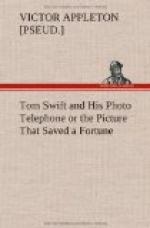“Dear Husband,” began Mrs. Damon. What the message was does not matter. It has nothing to do with this story. Sufficient to say that the moment the man began writing it down, as Tom could tell over the sensitive wire, by the scratching of the pencil—at that moment Tom, knowing the light was on in the distant telephone booth, switched on the picture-taking apparatus. His receiving apparatus at once indicated that the image was being made on the sensitive plate.
It took only a few seconds of time, and with the plate in the holder Tom hastened to the dark room to develop it. Ned took his chum’s place at the telephone, to see that all worked smoothly. The photo telephone had done it’s work. Whose image would be found imprinted on the sensitive plate? Tom’s hands trembled so that he could scarcely put it in the developing solution.
CHAPTER XXII
THE ESCAPE
Ned Newton, listening at the auxiliary telephone heard the man, to whom Mrs. Damon was dictating her message to her husband, utter an exclamation of impatience.
“I’m afraid I can’t take down any more,” he called. “That is enough. Now you listen. I want you to send me those papers.”
“And I am willing to,” went on Mrs. Damon, while Ned listened to the talk, the phonograph faithfully recording it.
“I wonder whose picture Tom will find,” mused Ned.
The unknown, at the other end of the wire, began giving Mrs. Damon a description of just what papers he wanted, and how to mail them to him. He gave an address that Ned recognized as that of a cigar store, where many persons received their mail under assumed names. The postal authorities had, for a long time, tried to get evidence against it
“That’s going to make it hard to get him, when he comes for the papers,” thought Ned. “He’s a foxy criminal, all right. But I guess Tom will turn the trick.”
Mrs. Damon was carefully noting down the address. She really intended to send the papers, if it proved that there was no other way in which she could secure the release of her husband. But she did not count on all of Tom’s plans. “Why doesn’t he develop that plate?” thought Ned. “He’ll be too late, in spite of his airship. That fellow will skip.”
It was at that moment that Tom came into the library. He moved cautiously, for he realized that a loud sound in the room would carry to the man at the other end of the wire. Tom motioned for Ned to come to him. He held out a dripping photographic plate.
“It’s Peters!” said Tom, in a hoarse whisper.
“Peters?” gasped Ned. “How could it be? His voice—”
“I know. It didn’t sound a bit like Peters over the ’phone, but there’s his picture, all right!”
Tom held up the plate. There, imprinted on it by the wonderful power of the young inventor’s latest appliance, was the image of the rascally promoter. As plainly as in life he was shown, even to his silk hat and the flower in his button-hole. He was in a telephone booth—that much could be told from the photograph that had been transmitted over the wire, but which booth could not be said—they were nearly all alike.




